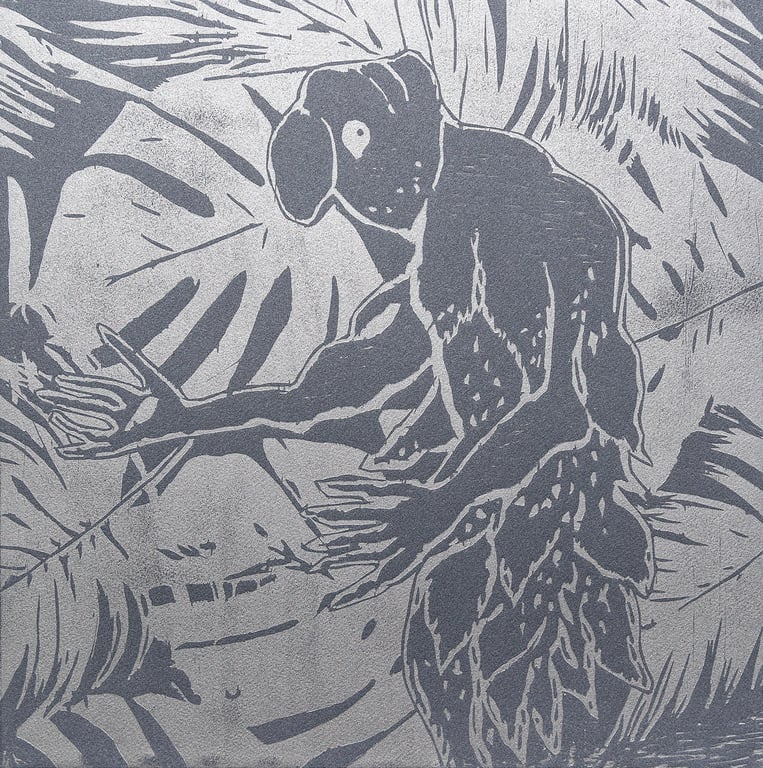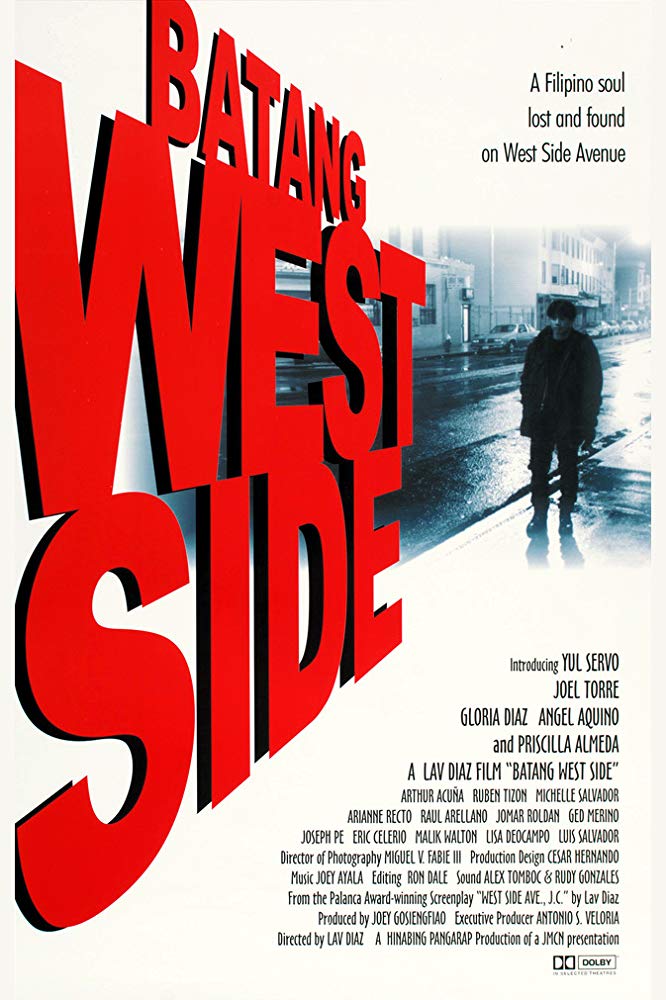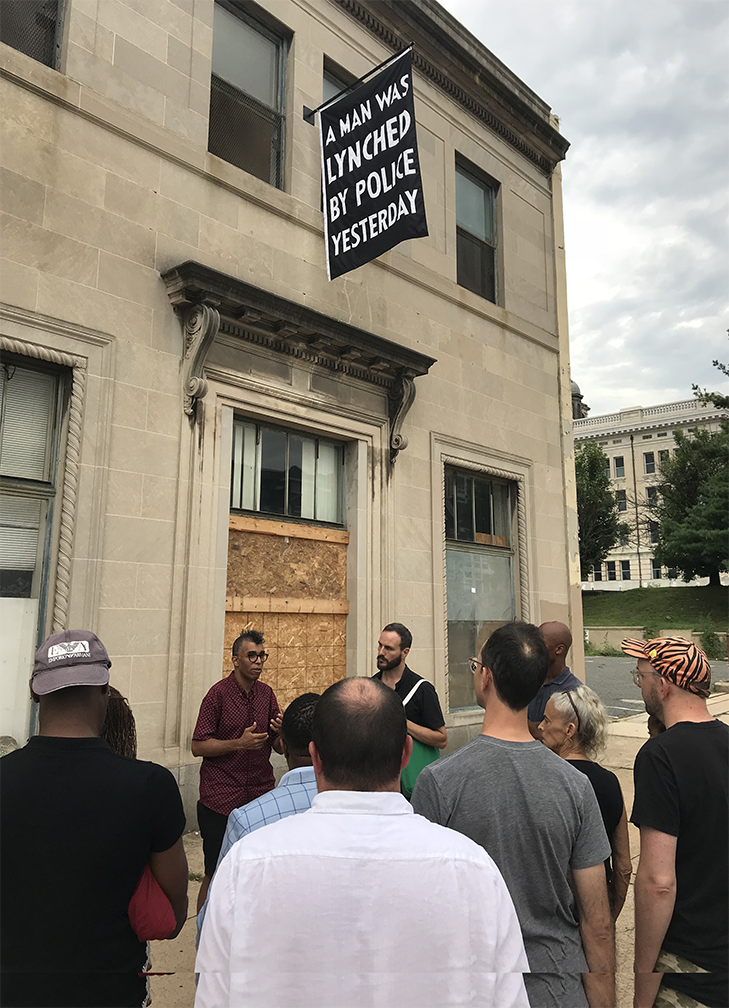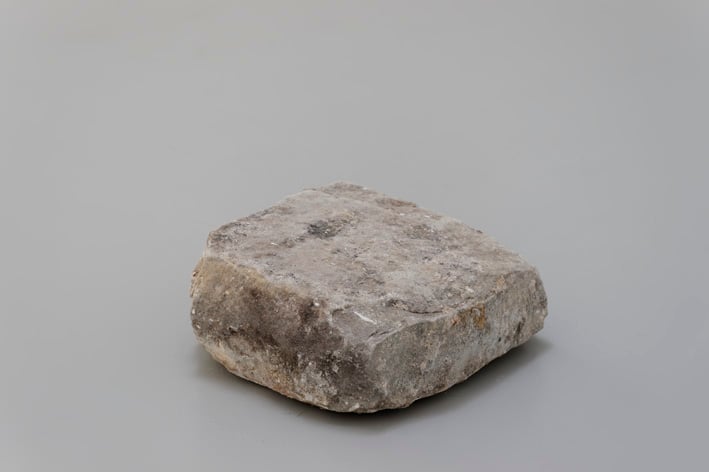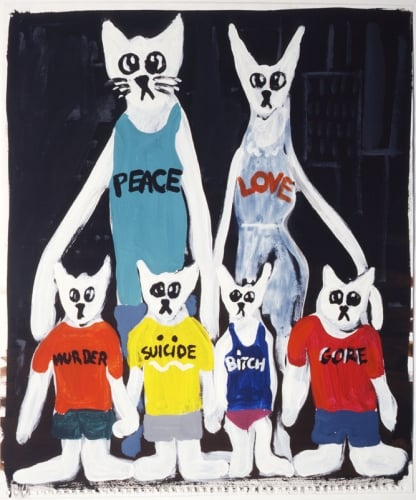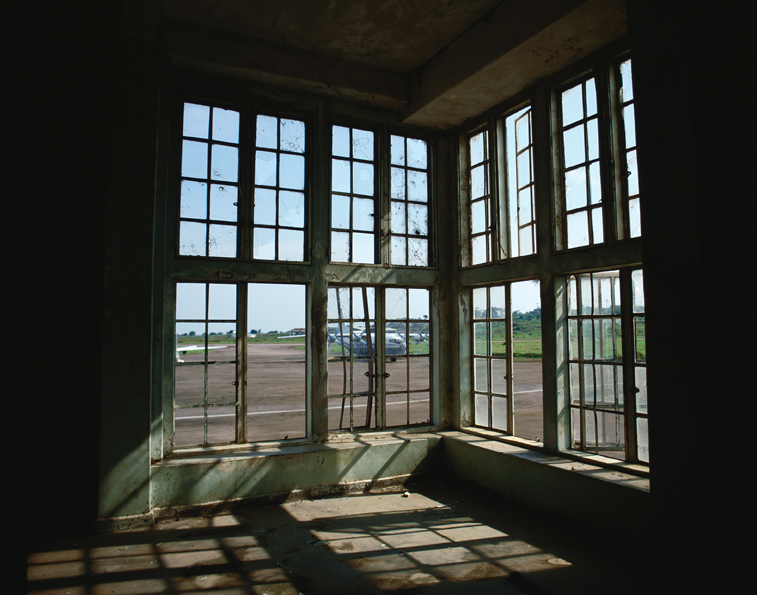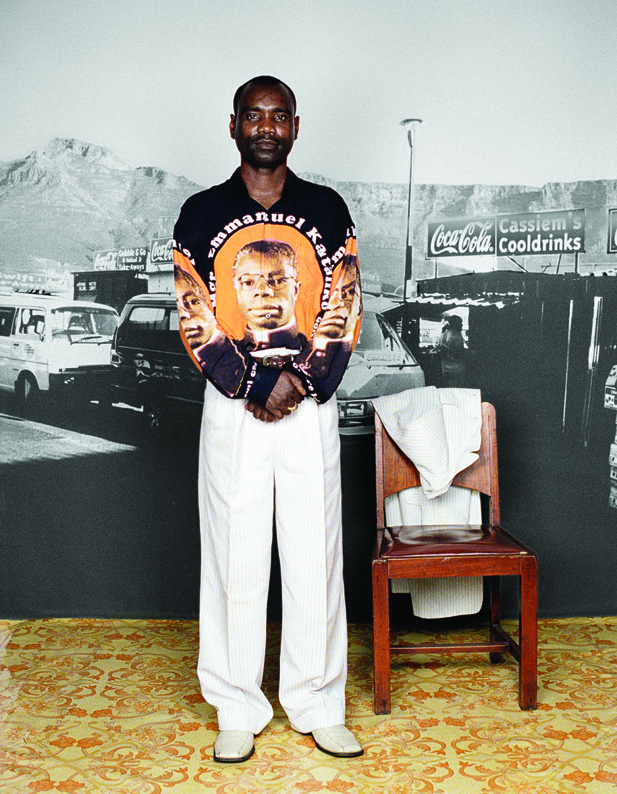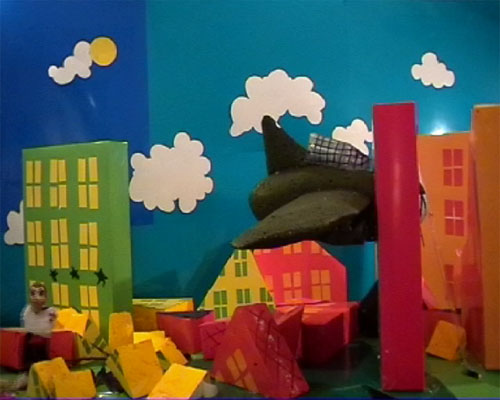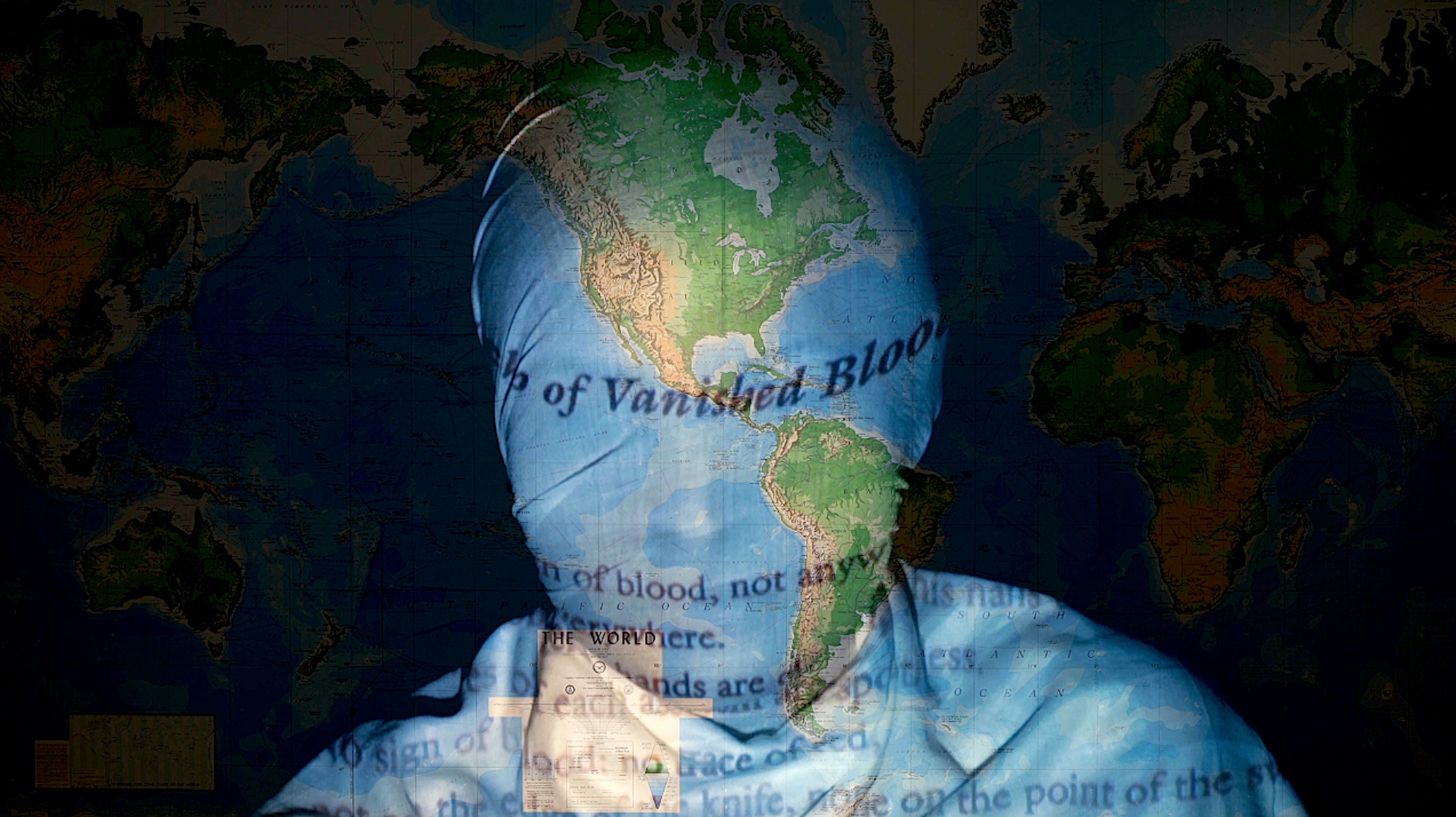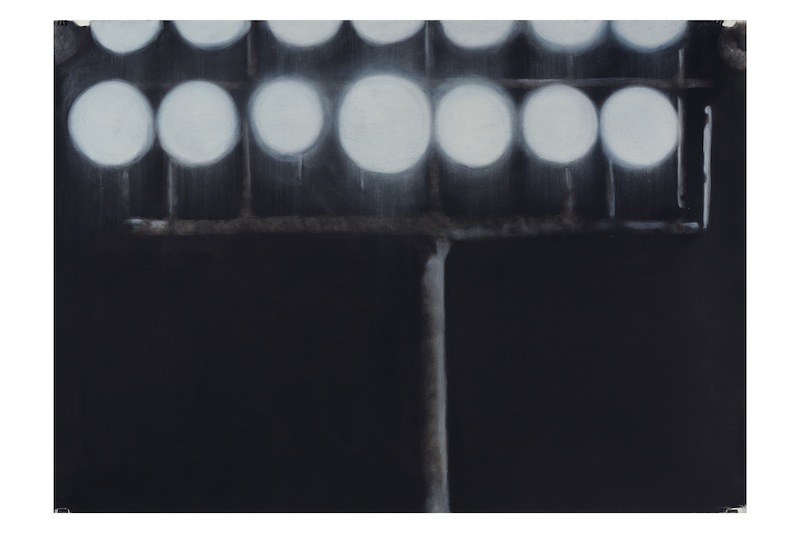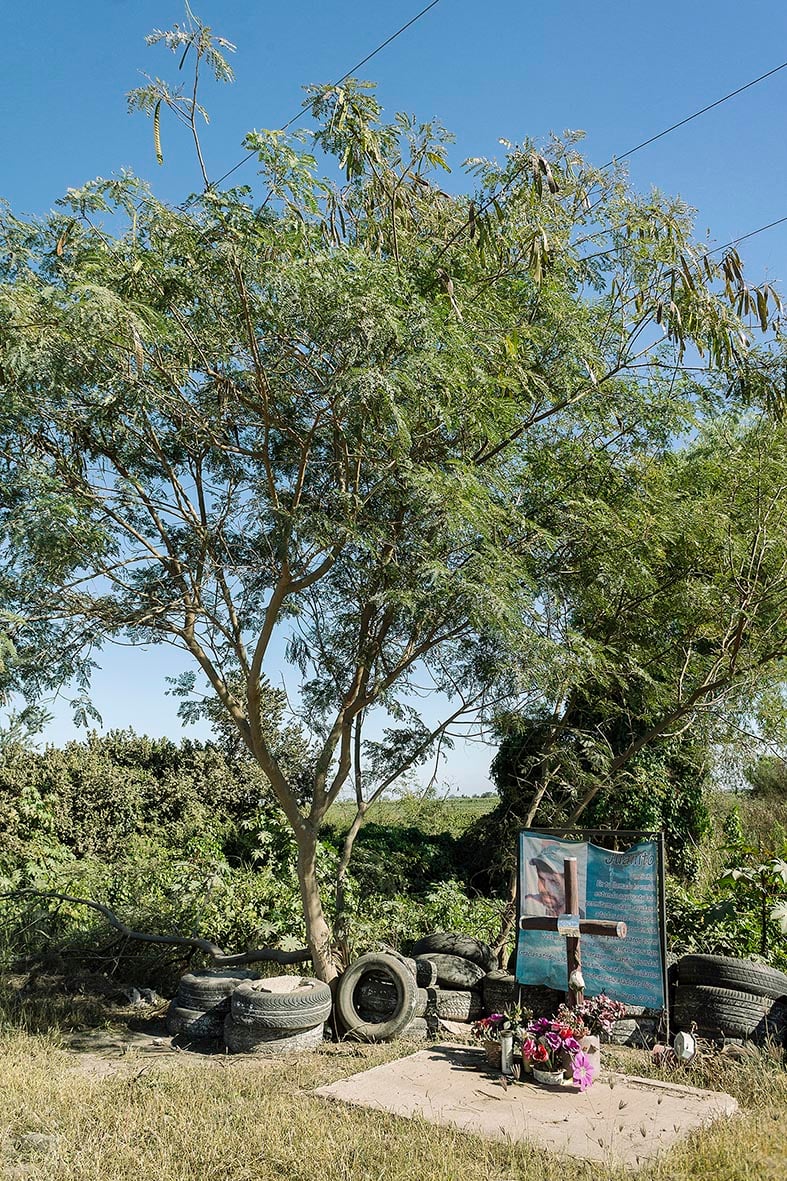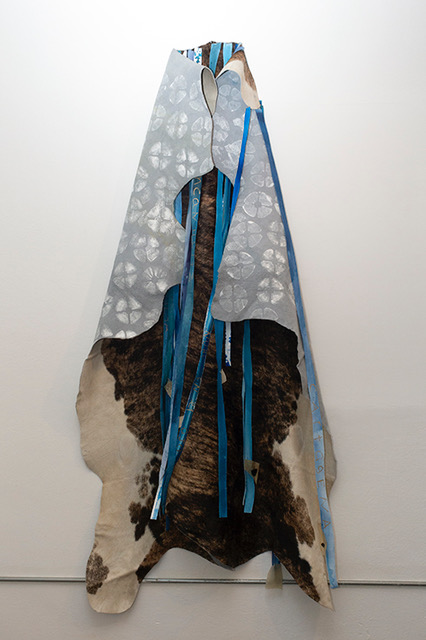
© » KADIST
Frida Orupabo
The archival images used by Frida Orupabo in her collages trace stereotyped representations of race, gender, sexuality and violence. Her works are developed through a process of decontextualization of such imagery, layering and recomposing, playing with new narratives. In this work she focuses on memory and what might be triggered in the viewer.
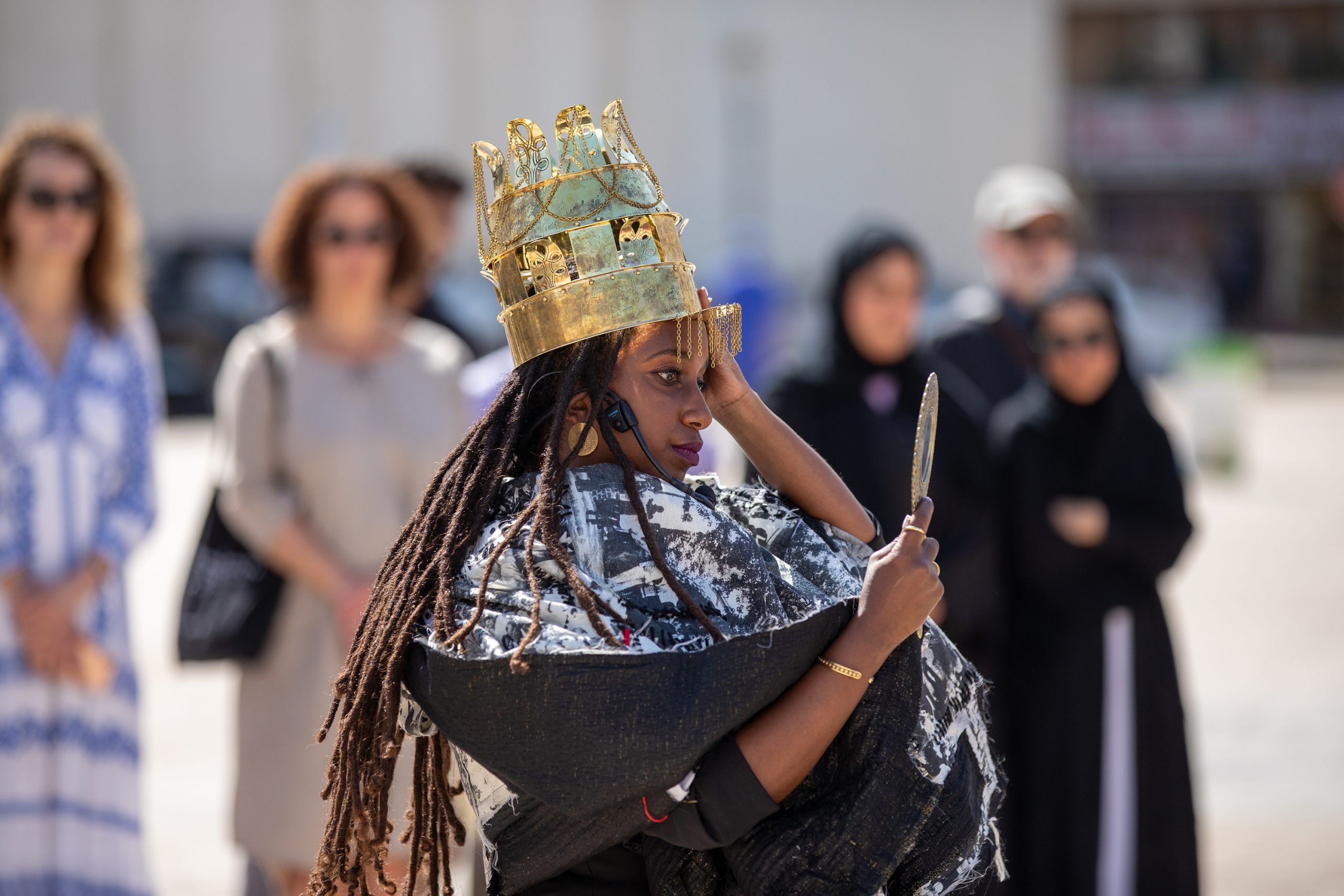
© » KADIST
Helina Metaferia
By Way of Revolution is a series of works by Helina Metaferia that addresses the inherited histories of protest that inform contemporary social movements. In the project, Metaferia works intrinsically with female descendants of prominent historical black activists to produce video art; with women of color organizations to produce socially engaged work; with “radicalism” archives and performance stills to produce works on paper and tapestries; and with museum, gallery, and public spaces to produce participatory performances. Tapestry (Gewel) (2023) is one of a series of tapestries that are all subtitled with names of traditional storytellers from across the African continent.

© » KADIST
Majd Abdel Hamid
Tadmur by artist Majd Abdel Hamid is influenced by a book by Mustafa Khalifa titled The Shell: Memoirs of a Hidden Observer , which details Khalifa’s imprisonment in the Assad ‘desert prison’ Tadmur. Khalifa’s compelling testimonial is now considered to have enlightened the Syrian public to the atrocities being committed in their country by the Assad regime and catalyzed a political resurgence in Syria. The prison was destroyed by ISIS in 2015 and though the initial reaction by the Syrian public was largely positive, the complete leveling of the prison erases the brutal experiences of the prisoners, many of whom died and those that survived.

© » KADIST
Park Chan-Kyong
Park Chan-Kyong’s otherworldly film Belated Bosal primarily follows two women as they navigate their way up a spectral mountain and through what appears to be a history museum or nuclear disaster bunker. They converge to jointly perform a funeral rite in a shipping container, which a group of artisans temporarily convert into a makeshift Buddhist temple, replete with traditional paintings. Shot in crisp and densely detailed black-and-white negative, each frame is lit by the format’s spooky incandescence: shadows are white and the sun is black, as if the world were being viewed through X-ray, infrared camera or a plutonium-sensitive film.

© » KADIST
Prabhakar Kamble
To produce the series of sculptures collectively titled Utarand , Prabhakar Kamble relocated his studio to Kolhapur, Maharashtra, near the village where he was born into a family of daily wage earners. Kamble cast the feet of agricultural workers in metal to prop up the eponymous terracotta pots traditionally used to store food and grains in every home. A commentary on the caste system’s four-tiered hierarchy, the pots become smaller as they go up the stand, mimicking the structure of society where most of the population is comprised of impoverished communities, which form the base of the caste system while a small minority makes up the wealthy upper castes.

© » KADIST
Prabhakar Kamble
To produce the series of sculptures collectively titled Utarand , Prabhakar Kamble relocated his studio to Kolhapur, Maharashtra, near the village where he was born into a family of daily wage earners. Kamble cast the feet of agricultural workers in metal to prop up the eponymous terracotta pots traditionally used to store food and grains in every home. A commentary on the caste system’s four-tiered hierarchy, the pots become smaller as they go up the stand, mimicking the structure of society where most of the population is comprised of impoverished communities, which form the base of the caste system while a small minority makes up the wealthy upper castes.
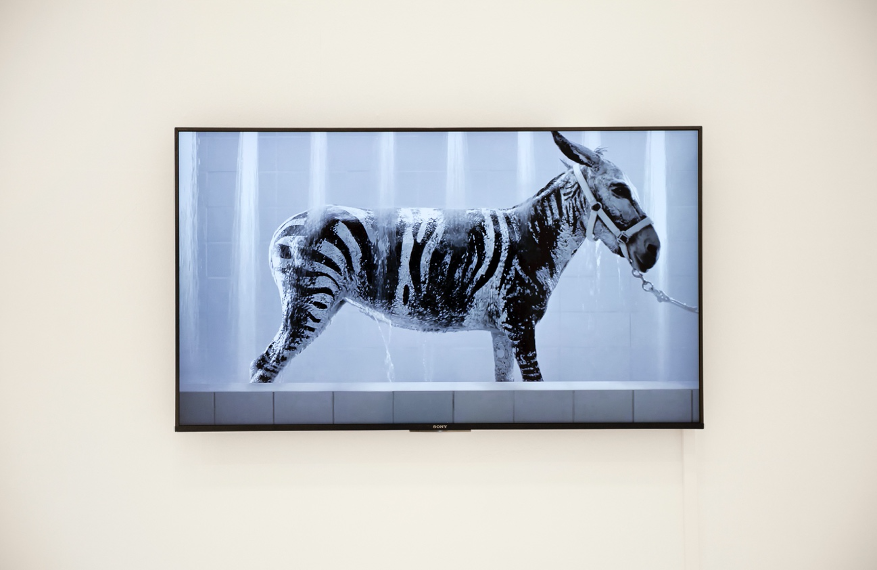
© » KADIST
Sharif Waked
Bath Time by Sharif Waked is a short video based on the tragi-comic outcome of the Israeli Blockade and the wars in Gaza. The story tells about how, after a war and the ongoing economic pressure, the Gaza Zoo lost several of their animals, and decided that they could paint a donkey so that it could pose as a zebra. The video imagines the donkey in the shower after a shift impersonating a zebra at the Gaza Zoo, as the hot water slowly washes its faux stripes away.

© » KADIST
Joaquín Segura
Pyre , an installation by Mexico City-based artist Joaquín Segura, addresses corruption, impunity, and the role that failed governments play in the normalization of violence. The work references mass disappearances at the hands of corrupt armed forces and paramilitary groups that have taken place in Mexico since the 1960s and significantly escalated over the last decade due to the War on Drugs. While the piece may be installed any number of ways, it is marked by the precision of its material content: 71 liters of gasoline, 23 used car tires, and 760 kilograms of wood.

© » KADIST
Joe Namy
Joe Namy’s Half Blue is an installation consisting of a video, a sound, and a sculpture, that triangulates a personal experience of the artist’s cousin Khalid Jabara, who was murdered by hate crime in Tulsa, Oklahoma, U. S. A in 2016. An event that garnered international attention, Jabara’s murder led to the Jabara-Heyer NO HATE Act passed by US Congress in 2021. The act was named after Jabara and Heather Heyer, two hate crime victims whose murders were prosecuted as hate crimes but not reported in hate crime statistics.

© » KADIST
Dana Kavelina
Letter to a Turtledove by Dana Kavelina is a short film based on a poem written by the artist. Delivered as a monologue and presented with subtitles, the poem encapsulates the traumas, grievances, horrors, dreams, and hallucinations that have descended upon Ukraine’s Donbass region since its invasion by Russia in 2014. Appropriating amateur footage shot during the war in the Donbass region, Kavelina’s film weaves sound and image into a poignant tapestry that considers the absurdity of war.
![Elevación [Elevation]](https://kadist.org/wp-content/uploads/2022/09/IMG_escena001_3513-scaled.jpg)
© » KADIST
Ana María Millán
Interested in role-play and videogames, Ana María Millán developed workshops with different communities in order to create characters and scenarios for her animations, often in collaboration with a choreographer. Elevación evokes various narratives inspired by the comicstrip Marquetalia, Raíces de la Resistencia (Marquetalia, Roots of the Resistance) (2011). This comic strip is a memoir of the FARC (Revolutionary Armed Forces of Colombia) guerillas written by Jesús Santrich, one of its leaders who, after the 2016 Peace Agreement, rejoined dissident members of the organization in a clandestine guerrilla splinter group in 2019.

© » KADIST
American Artist
From suicides, to gang violence, to the epidemic abuse of force by police departments (predominantly against Black men), to school and mass shootings, there is perhaps no more urgent issue in the United States than gun control. The color blue is a proxy for both sadness, and a color that is emblematic of American law enforcement services. I Am Blue, 1 by American Artist is a sculpture that fuses a school desk with a ballistic shield.

© » KADIST
Sheelasha Rajbhandari
Agony of the New Bed by Sheelasha Rajbhandari brings out the familiar yet often ignored reality of gender discrimination and taboos built within the construct of marriage. Part of the artist’s series Marriage Taboos , these portraits of women from different age groups in Nepal are staged on cotton mattresses placed on miniature golden matrimonial beds. The embroidered text on top of the portraits in golden threads are a representation of the range of vulnerable and resilient emotions experienced by women and the social beliefs towards them.

© » KADIST
Pichet Piaklin
The Wings by Pichet Piaklin is a creation story of fragility, where the desire for freedom is mired in blood red by the inculcation of faith and violence. Piaklin was born and continues to live and work in Thailand’s deep south, a geographical area once known as the Pattani Kingdom (now the Pattani, Yala, and Narathiwat provinces), before it was annexed by the Siam Kingdom in the early 1900s. As a consequence of unreconciled historical conflict, this predominantly Muslim community continues to endure oppressive social and political conditions under the ruling Thai Buddhist monarchy.

© » KADIST
Prabhakar Kamble
To produce the series of sculptures collectively titled Utarand , Prabhakar Kamble relocated his studio to Kolhapur, Maharashtra, near the village where he was born into a family of daily wage earners. Kamble cast the feet of agricultural workers in metal to prop up the eponymous terracotta pots traditionally used to store food and grains in every home. A commentary on the caste system’s four-tiered hierarchy, the pots become smaller as they go up the stand, mimicking the structure of society where most of the population is comprised of impoverished communities, which form the base of the caste system while a small minority makes up the wealthy upper castes.

© » KADIST
Native Art Department International
The neon sign Walk the Walk (Sam Durant) overlays a Walk/Don’t Walk Sign crosswalk sign onto the text “You Are On Indian Land Show Some Respect.” The sign asks viewers to not walk on Indigenous lands without respecting it, and, switching between a walking person icon in white and a raised hand icon in red, redirects their actions. This work by Native Art Department International signals a reminder that we–the audience and institution–are located on and occupy traditional territories. The work appropriates and twists white artist Sam Durant’s You Are On Indian Land Show Some Respect (2008) in response to his work Scaffold (2012) installed in 2016-7 at the Walker Art Center in Minneapolis.

© » KADIST
Mona Marzouk
Trayvon is a series of acrylic paintings by Mona Marzouk that engages the courtroom as its points of departure. The courtroom as a space for the implementation of justice and of legal argumentation, but also through which different affective forces, some hegemonic and others marginalized, battle each other out in their respective quests for acknowledgment, accountability, and retribution. The work was produced at a time during which several popular revolts, such as in Egypt, seemed to have effectively been hijacked by reactionary forces, resulting in the violent dismissal of collective demands for emancipation, including through sham trials and wrongful convictions criminalizing activists, journalists, and protesters.

© » KADIST
Santiago Yahuarcani
Drawing & Print (Drawing & Print)
The series Castigos del caucho by Santiago Yahuarcani originates in the oral memory transmitted by the artist’s grandfather, who was a survivor of the Putumayo genocide where thousands of Indigenous people were annihilated and enslaved to extract rubber from the Amazon forest between 1879 and 1912. Yahuarcani’s complex narrative paintings on tree bark highlight a long history of colonial violence against the Uitoto and other Indigenous communities. They also show the destruction of the rainforest under Western models of extraction, privatization, and development.

© » KADIST
Helina Metaferia
By Way of Revolution is a series of works by Helina Metaferia that addresses the inherited histories of protest that inform contemporary social movements. In the project, Metaferia works intrinsically with female descendants of prominent historical black activists to produce video art; with women of color organizations to produce socially engaged work; with “radicalism” archives and performance stills to produce works on paper and tapestries; and with museum, gallery, and public spaces to produce participatory performances. The Call is an ongoing video project of performances by descendants of prominent civil rights activists across the United States.

© » KADIST
Emmanuel van der Auwera
Emmanuel van der Auwera visited Miami at the end of 2017 and was working on a project relating to school shootings. Two months later, on 14 February 2018, 19 year old Nicolas Cruz killed 17 people and injured 17 others in a shooting at the Marjory Stoneman Douglas High School in Parkland, Florida. Van de Auwera began to follow videos uploaded to the Periscope App, a live broadcasting channel that closed in March 2021, downloading them and creating a bank of data that would otherwise disappear, as material on Periscope was self-deleting after a short period of time.

© » KADIST
Manuel Correa
Manuel Correa’s documentary Four Hundred Unquiet Graves is a powerful and vulnerable visual essay about the descendants of those who were disappeared during the Spanish Civil War from 1936–1939. The film reveals the spectrum of violence that surrounds the war, namely the impact of thousands of forced disappearances on different generations. Surviving family members are haunted not only by the absence of their grandparents, but also by the overwhelming grief that lives in their parents.

© » KADIST
Pratchaya Phinthong
Pratchaya Phinthong’s work has explored the mineral and karmic economies of Laos, a country that shares language, beliefs, and a long border with his own native region of Isaan (Northeast Thailand). The most bombed nation on earth, Laos still bears the physical and mental scars of the U. S. military’s epic aerial offensive, launched largely from bases in Isaan, during the Second Indochina War. Between 1964 and 1973 the US dropped an estimated 250 million cluster bombs on Laos.

© » KADIST
Mona Marzouk
Trayvon is a series of acrylic paintings by Mona Marzouk that engages the courtroom as its points of departure. The courtroom as a space for the implementation of justice and of legal argumentation, but also through which different affective forces, some hegemonic and others marginalized, battle each other out in their respective quests for acknowledgment, accountability, and retribution. The work was produced at a time during which several popular revolts, such as in Egypt, seemed to have effectively been hijacked by reactionary forces, resulting in the violent dismissal of collective demands for emancipation, including through sham trials and wrongful convictions criminalizing activists, journalists, and protesters.

© » KADIST
Kathy Jetnil-Kijiner
Anointed by Kathy Jetnil-Kijiner and Dan Lin is a poem recital/video that addresses the American nuclear testing legacy in the Marshall Islands that occurred between 1946 to 1958 in Bikini and Enewetak Atolls. The artist’s words of resilience and healing are uttered as she travels across the northeastern atolls of her vast island nation. The climax of the short film takes place when the artist, holding white coral stones (a Marshallese funeral ritual) stands on top of the massive concrete dome erected on Runit Island in Enewetak Atoll to contain 73,000 square meters of radioactive waste—only a small fraction of the debris generated by the nuclear tests, the rest of which was never cleaned up.

© » KADIST
Pratchaya Phinthong
Pratchaya Phinthong’s work has explored the mineral and karmic economies of Laos, a country that shares language, beliefs, and a long border with his own native region of Isaan (Northeast Thailand). The most bombed nation on earth, Laos still bears the physical and mental scars of the U. S. military’s epic aerial offensive, launched largely from bases in Isaan, during the Second Indochina War. Between 1964 and 1973 the US dropped an estimated 250 million cluster bombs on Laos.

© » KADIST
Lungiswa Gqunta
Feet Under Fire by Lungiswa Gqunta depicts the artist’s lower legs swinging in and out of frame, above a bed of charcoal. She wears a pleated white dress, two identical white anklets, and a set of bristle brushes as shoes. Affixed to the base of each scrubbing brush is a black strap so that the brushes don’t fall off of her feet.

© » KADIST
Aziz Hazara
Youthfulness and gestures of play are central to Aziz Hazara’s practice. The artist uses these mechanisms as a lens to give pause to the behaviours of children as foreboding reflections of the enduring and all-pervasive effects of conflict and war. In the short video Rehearsal the artist documents two young Afghan boys imitating the guttural rattling of an automatic rifle, play-shooting in the field in front of them, and swivelling as if to suggest the gun is mounted.

© » KADIST
Manuel Correa
La Forma del Presente (The Shape of Now) by Manuel Correa follows a group of survivors of Colombia’s 50-year long armed conflict facing the impossible task of agreeing on a shared past. After half a century of carnage, Colombia achieved peace. Despite an agreement between the government and the Revolutionary armed forces of Colombia (FARC_EP) being rejected by popular vote, the government chose to implement the agreements regardless, further polarizing the public opinion.

© » KADIST
Luis Pazos
La Cultura de la Felicidad (The Culture of Happiness) is a series of five photographs addressing everyday life—a couple in a bed, lovers on a bench and a family reunion. The subjects wear masks made of white cardboard. The series suggests the idea of a reality hidden under the appearances of the power in place that denies violence to citizens.

© » KADIST
Taiki Sakpisit
A Ripe Volcano , a collaboration with Yasuhiro Morinaga, revisits two sites of violence and aggression in Thailand’s recent past: The Rattanakosin Hotel, the site where the military troops captured and tortured the civilians, students and protestors who were hiding inside the hotel during the Black May of 1992; and Ratchadamnoen Stadium, a Roman amphitheater-style Muay Thai boxing arena, which was built in 1941-45 during the Second World War and since then has become the theatrical labyrinth for more acculturated and commercially “acceptable” displays of bloodshed. The work builds around the recollections of human experiences that took place within these spaces and shifts through the mental space distilled from the possessed memory of wounded time. Within the medium of the multi-channel video/ sound installation, Sakpisit and Morinaga create dreamlike variations sprawling through darkened room where the haunting images and ambient sounds float through the space, creating an exquisitely hypnotizing experience.
Wang Tuo
Through film, performance, painting, and drawing, artist Wang Tuo interweaves disparate realities through archives, modern history, myth, and literature...
Prabhakar Kamble
Prabhakar Kamble is an artist, curator, and cultural activist...
Nikita Kadan
Trained in large-scale painting, Nikita Kadan’s artistic practice encompasses installation, graphics, painting, wall drawing, and urban postering, sometimes in collaboration with architects, human rights activists, and sociologists...
Claudia Joskowicz
Claudia Joskowicz is a video and installation artist working at the intersection of landscape, history, and memory...
Maya Watanabe
Drawing on her background in theater design and direction, Maya Watanabe is known for her multi-channel video installations that explore the relationship between language, collectivity, identity, and space...
Manuel Correa
Manuel Correa’s practice deals with the reconstruction of post-conflict intergenerational memory in contemporary societies...
Pratchaya Phinthong
Pratchaya Phintong’s works often arise from the confrontation between different social, economic, or geographical systems...
Mona Marzouk
Mona Marzouk is an artist whose practice is deeply rooted in a keen sense for architecture...
Helina Metaferia
Helina Metaferia is an interdisciplinary artist working across collage, assemblage, video, performance, and social engagement...
Reza Aramesh
Working across a wide range of materials and processes, Aramesh examines simultaneously the history of Western art and contemporary commentary on the politics and history of the Middle East, concocting a unique visual language to address the contemporary conditions of violence and bio-politics...
James T. Hong
James T...
Chitra Ganesh
Spanning printmaking, sculpture, and video, Chitra Ganesh’s work draws from broad-ranging material and historic reference points, including surrealism, expressionism, Hindu, Greek and Buddhist iconographies, South Asian pictorial traditions, 19th-century European portraiture and fairy tales, comic books, song lyrics, science fiction, Bollywood posters, news and media images...
Felipe Dulzaides
Felipe Dulzaides studied drama at the Instituto Superior de Arte of Havana and received a MFA in New Genres from the San Francisco Art Institute...
Orion Shepherd
Orion Shepherd is a Los Angeles based artist working across drawing, collage, painting and sculpture...
Park Chan-Kyong
Artist and filmmaker Park Chan-kyong was born in Seoul under the reign of Park Chung-hee, whose authoritarian rule transformed South Korea from an impoverished, war-torn country into what the artist describes as a ‘militaristic, repressive, modern state.’ The shadows of Japanese occupation and the Korean War loomed large over the period, driving the call for nationalism and productivity...
Kota Ezawa
- location: San Francisco, California
- year born: 1969
- gender: male
- nationality: German
- home town: Cologne, Germany
Imran Qureshi
Pakistani artist Imran Qureshi’s practice revives 16th century Mughal miniature painting...
Brook Andrew
Brook Andrew is a Wiradjuri and Ngunnawal Aboriginal Australian artist and scholar whose interdisciplinary practice examines hegemonic narratives relating to colonialism and modernism...
Jumana Manna
Jumana Manna is a Berlin-based artist whose work revolves around the body, national identity, and historical narratives...
Li Liao
- location: Shenzhen, China
- year born: 1982
- gender: male
- nationality: Chinese
- home town: Hubei Province, China
Tuan Andrew Nguyen
Tuan Andrew Nguyen is an artist and filmmaker, one of the three founders of The Propeller Group created in 2006...
The Atlas Group
The Atlas Group is a research and artistic project founded by Lebanese artist Walid Raad in 1999...
Indira Allegra
Indira Allegra uses text and textile production—a combined material they designate as a “text/ile”—to embody unseen forces like memory, haunting, grief, and emotions born from trauma...
Frida Orupabo
A central element of Frida Orupabo’s practice is her digital archive, storing images from both the media and from her personal life on her Instagram account, later transforming them into analogue collages...
Bunny Rogers
Like many others of her generation, Bunny Rogers discovered herself through digitally mediated experiences on the Internet, finding outlets online that didn’t exist for her in the reality of her Texas upbringing...
Shay Arick
Violence is key to Shay Arick’s practice who employs photography, sculpture, performance, video and drawing as means to understand what motivates people to enact it...
Santiago Yahuarcani
Santiago Yahuarcani belongs to the Aimen+ (White Heron) clan of the Uitoto people of the northern Amazon...
Christian Nyampeta
Christian Nyampeta’s works investigate how individuals and communities negotiate forms of socially-organized violence...
Ali Eyal
Artist Ali Eyal’s practice aims to explore the complex relationship between community and politics using different media such as video, installation, photography, and painting...
Maryam Hoseini
Maryam Hoseini makes delicate, figurative paintings to investigate the political, social, and personal conditions of identity and gender...
-
1970-1979
Luis Pazos
1971La Cultura de la Felicidad (The Culture of Happiness) is a series of five photographs addressing everyday life—a couple in a bed, lovers on a bench and a family reunion...
Gabriel Borba Filho
1975Gabriel Borba Filho was aware of what was happening on the other side of the Atlantic, and Untitled (Nos) is linked to both the social and political climates in Brazil and Spain during the Franco period...
-
1990-1999
The Atlas Group
1991This image is an extract from a notebook in the archives of doctor Fakhouri that lists the cars that have been used for bombs between 1975 and 1991...
John Baldessari
1997In One Must , an image of a pair of scissors, accompanied by the words of work’s title, poses an ominous question about the relationship between the image and the text...
Collier Schorr
1999Collier Schorr’s prints upend conventions of portrait photography by challenging what it means to “document” a subject...
-
2000-2009
Zarina Bhimji
2001Born in Uganda of Indian descent, Bhimji has lived in London after her family sought refuge from the regime of Idi Amin who compulsorily expelled all Asians from Uganda...
Kota Ezawa
2002The Simpson Verdict is a three-minute animation by Kota Ezawa that portrays the reading of the verdict during the OJ Simpson trial, known as the “most publicized” criminal trial in history...
Sue Williamson
2003In her 2003 series “Better Lives”, Sue Williamson explores stories of immigrants in search of a better life in a historically contentious South Africa...
Alain Séchas
2003A cat, standing like a human being, is looking at us with round and dazed eyes and holds a gun...
Nathalie Djurberg
2004Apparently Djurberg’s mother made a puppet theater and traveled around Göteborg performing during her childhood...
Pavel Wolberg
2004A young settler girl, dressed in a bridal outfit for Purim, stands in a street in Hebron waiting, perhaps for her parents or other children to join her...
Kelley Walker
2004The triptych Black Star Press is part of the series ‘The Black Star Press project’ initiated in 2004 by the American artist Kelley Walker...
Jennifer Locke
2005Choke documents the artist filming a wrestler “choking out” his teammate until he is unconscious...
Kara Walker
2005In her masterpiece 8 Possible Beginnings or The Creation of African-America , Walker unravels just that, the story of struggle, oppression, escape and the complexities of power dynamics in the history following slave trade in America...
Ruijun Shen
2006In Seven Deadly Sins (2006), Shen utilizes abstraction to produce complex topographies of color that evoke associations with violently tumultuous landscapes...
Felipe Dulzaides
2006I Am Cuba— “Soy Cuba” in Spanish; “Ya Kuba” in Russian—is a Soviet/Cuban film produced in 1964 by director Mikhail Kalatozov at Mosfilm...
Alejandro Marré
2007Typical Weapons is a series of sculptural interventions where Alejandro Marre transforms traditional Guatemalan craft objects usually sold as souvenirs into weapons...
Claudia Joskowicz
2007The primary interest in the trilogy is Joskowicz’s use of cinematic space, with long tracking shots that portray resistance to habitual viewing experiences of film and television...
Jazmín López
2008Shot on 35mm in two simply framed shots, Jazmín López’s Juego Vivo captures children at play, mixing imagination, reality, innocence, and violence...
-
2010-2019
Orion Shepherd
Drawing & Print
2010(Drawing & Print) Ballad of the Unabomber Part I is a painting by Orion Shepherd that features several manila folders stacked in order according to their size, resting atop a grainy hardwood pattern...
Taiki Sakpisit
2011A Ripe Volcano , a collaboration with Yasuhiro Morinaga, revisits two sites of violence and aggression in Thailand’s recent past: The Rattanakosin Hotel, the site where the military troops captured and tortured the civilians, students and protestors who were hiding inside the hotel during the Black May of 1992; and Ratchadamnoen Stadium, a Roman amphitheater-style Muay Thai boxing arena, which was built in 1941-45 during the Second World War and since then has become the theatrical labyrinth for more acculturated and commercially “acceptable” displays of bloodshed...
Eamon Ore-Giron
2011Eamon Ore-Giron’s new commissioned video project Bite Work, is an experimental genre breaking video that is part-performance, part-conceptual and part-comical addressing issues of mediation, surveillance and trust...
Sharif Waked
2012Bath Time by Sharif Waked is a short video based on the tragi-comic outcome of the Israeli Blockade and the wars in Gaza...
James T. Hong
2012Taiwan WMD (Taiwan and Weapons of Mass Destruction) is part of a long-term research started in early 2010 on the history and aftermath effects of Japanese biological and chemical warfare in China during WWII, as well as the unknown history of Taiwan’s nuclear program...
Dawoud Bey
2012On 15 September 1963 members of the Ku Klux Klan blew up the 16th Street Baptist Church in Birmingham Alabama up using dynamite...
Tuan Andrew Nguyen
2012This work presents the image of an immolated monk engraved on a baseball bat...
Nalini Malani
2012Malani draws upon her personal experience of the violent legacy of colonialism and de-colonization in India in this personal narrative that was shown as a colossal six channel video installation at dOCUMENTA (13), but is here adapted to single channel...
Nikita Kadan
Drawing & Print
2013(Drawing & Print) Ukraine is under tension due to the politics of President lanoukovitch since 2010...
Haig Aivazian
Drawing & Print
2013(Drawing & Print) This work is part of an ongoing project that looks at international sports competitions as a revealing element of nationalistic aspirations which present contradictions...
Nikita Kadan
Drawing & Print
2013(Drawing & Print) Ukraine is under tension due to the politics of President lanoukovitch since 2010...
Phan Thao Nguyên
2013On September 22, 1940 the French signed an accord, which granted Japanese troops the right to occupy Indochina...
Shay Arick
2013Part of a series of videos called LIFE, where Shay Arik videos that re-enact iconic journalistic photographs...
Igor Grubic
2013The installation “East Side Story” is based on events that took place in the streets of Belgrade in 2001 and Zagreb in 2002, during the Gay Pride demonstrations, where the participants were the victims of verbal and physical injury by neo-Nazi groups and other citizens...
Regina José Galindo
2013In 2012, former Guatemalan President José Efran Ros Montt was charged with genocide and crimes against humanity; Regina José Galindo’s video Tierra is a chilling reimagining of the atrocities recounted during his trial...
Mona Marzouk
2014Trayvon is a series of acrylic paintings by Mona Marzouk that engages the courtroom as its points of departure...
Mona Marzouk
2014Trayvon is a series of acrylic paintings by Mona Marzouk that engages the courtroom as its points of departure...
Jesús Hdez-Güero
2014Minutos de odio contra sí mismo (Minutes of hate against itself) is a simple and powerful work about the political situation in Venezuela, replacing the stars on the flag with bullet holes...
Bunny Rogers
2014In Rogers’ Columbine works, the artist explores the 1999 high school shooting that took place in Littleton, Colorado, claiming 34 victims...
Teresa Margolles
2014Stretching between San Pedro and the beach in Altata, Sinaloa, there is a 40 km road where there are three invisible borders controlled by rivalling armed groups...
Maya Watanabe
2014In Escenarios (Sceneries) Maya Watanabe films forgotten wastelands through a series of 360° camera movements that highlight the dramatism and visual richness of terrain that would be otherwise forgotten...
Claudia Joskowicz
2014Los rastreadores is a two-channel video by Claudia Joskowicz narrating the story of a fictitious drug lord, Ernesto Suarez, whose character is based on the well-known Bolivian drug dealer, Roberto Suárez...
Hank Willis Thomas
Drawing & Print
2014(Drawing & Print) Shot in black and white and printed on a glittery carborundum surface, Black Hands, White Cotton both confronts and abstracts the subject of its title...
Christine Rebet
2015In the Soldier’s Head evokes the traumas of war through the prism of the hallucinations of a soldier...
Jumana Manna
2015Blue Elbow (Coude bleu) is made from plaster, burlap, lacquer, pigments and plastics...
Jorge de León
2015Jorge de León most well-known work was a radical gesture, and one of his earliest artworks: in his 2000 performance, The Circle, de León sewed his own mouth closed as a protest against the silencing of citizens in the face of social corruption...
Ibro Hasanovic
2015Note on Multitude is a chilling black-and-white short movie recorded with a single camera in Prishtina, Kosovo, in 2015...
Aslan Goisum
2015The video work Volga by Aslan Goisum begins with a sweeping field caught under a misty, gray sky...
Claudia Joskowicz
2015Some Dead Don’t Make a Sound (Hay muertos que no hacen ruido) is a single-channel video by Claudia Joskowicz that features the Mexican legend of the Weeping Woman (La Llorona) as its main protagonist...
Joaquín Segura
2016Pyre , an installation by Mexico City-based artist Joaquín Segura, addresses corruption, impunity, and the role that failed governments play in the normalization of violence...
Uriel Orlow
2016The series The Memory of Trees is specifically about trees, and what trees have witnessed in South Africa: for example, trees that were used as locations for slave trading, or trees that was during the anti-Apartheid struggle as a kind of identifier for a safe house for activists who were fleeing from security forces...
Lawrence Abu Hamdan
2016In May 2014, Israeli soldiers shot and killed two teenagers, Nadeem Nawara and Mohamad Abu Daher in occupied Palestine (West Bank)...
Reza Aramesh
2016The photographed plaster heads set against the idyllic landscapes of the south of England, subvert the process of image production and memory...
Reza Aramesh
2016The photographed plaster heads set against the idyllic landscapes of the south of England, subvert the process of image production and memory...
Titus Kaphar
2016Although the objects depicted in Titus Kaphar’s diptych 2016/1963 might not be immediately recognizable, the work’s title and the inscriptions ‘Alabama 1963’ and ‘North Dakota 2016’ reveal their use as tools of brutal force...
Nohemí Pérez
Drawing & Print
2016(Drawing & Print) A rich and isolated region, El Catatumbo is located near the border with Venezuela...
Santiago Yahuarcani
Drawing & Print
2017(Drawing & Print) The series Castigos del caucho by Santiago Yahuarcani originates in the oral memory transmitted by the artist’s grandfather, who was a survivor of the Putumayo genocide where thousands of Indigenous people were annihilated and enslaved to extract rubber from the Amazon forest between 1879 and 1912...
Lungiswa Gqunta
2017Feet Under Fire by Lungiswa Gqunta depicts the artist’s lower legs swinging in and out of frame, above a bed of charcoal...
Imran Qureshi
2017At first glance, This Day by Imran Qureshi appears to be an energetic, gestural painting reminiscent of Action Painting from the mid-20th century...
Arin Rungjang
2017246247596248914102516… And then there were none narrates a semi fictional account centered around the ambiguous history of the Democracy Monument in Bangkok, and on the aftermath of the 1973 demonstration of 400,000 people who marched against the military junta from Thammasat University to the monument...
Colectivo Los Ingrávidos
2017The word Coyolxauhqui refers to femicide or the killing of women in rural Mexico on the basis of gender...
Jorge Julián Aristizábal
Drawing & Print
2017(Drawing & Print) La Masacre de el Aro (The Massacre of El Aro) by Jorge Julián Aristizábal refers to a massacre in Colombia which occurred on October 22, 1997 in the municipality of Ituango, Department of Antioquia...
Michael Rakowitz
2017The Ballad of Special Ops Cody by Michael Rakowitz is a serio-comic stop motion animated film in which an everyday African-American G...
Martha Colburn
2017Martha Colburn’s film, Western Wild … or How I Found Wanderlust and Met Old Shatterhand , about the famed German author Karl May weaves together a mixture of stop motion animation, travelogue and biography that generates a kind of sensory wanderlust...
Frida Orupabo
2018The archival images used by Frida Orupabo in her collages trace stereotyped representations of race, gender, sexuality and violence...
Sheelasha Rajbhandari
2018Agony of the New Bed by Sheelasha Rajbhandari brings out the familiar yet often ignored reality of gender discrimination and taboos built within the construct of marriage...
Native Art Department International
2018The neon sign Walk the Walk (Sam Durant) overlays a Walk/Don’t Walk Sign crosswalk sign onto the text “You Are On Indian Land Show Some Respect.” The sign asks viewers to not walk on Indigenous lands without respecting it, and, switching between a walking person icon in white and a raised hand icon in red, redirects their actions...
Kathy Jetnil-Kijiner
2018Anointed by Kathy Jetnil-Kijiner and Dan Lin is a poem recital/video that addresses the American nuclear testing legacy in the Marshall Islands that occurred between 1946 to 1958 in Bikini and Enewetak Atolls...
Manuel Correa
2018La Forma del Presente (The Shape of Now) by Manuel Correa follows a group of survivors of Colombia’s 50-year long armed conflict facing the impossible task of agreeing on a shared past...
Nikita Kadan
Drawing & Print
2018(Drawing & Print) East of Ukraine became a place of armed conflict with Russia-backed separatists, who proclaimed parts of (the) Donetsk and Lughansk oblast (administrative region in Ukrainian) to be ‘People’s republics’...
Chitra Ganesh
2018Silhouette in the Graveyard is part of a suite of animated videos by Chitra Ganesh titled The Scorpion Gesture ...
Indira Allegra
2018Open Casket IX is an installation by Indira Allegra that combines traditional materials of memorial—tombstones, mausoleums, and caskets—with contemporary expressions of grief...
Jota Mombaça
2018The performance title A Gente Combinamos De Não Morrer (BANDEIRA #1) / Us Agreed Not To Die (FLAG #1) is taken from a short story by Brazilian writer Conceição Evaristo, whose work addresses violence, resilience, and necropolitics with an Afro-diasporic lens...
Christian Nyampeta
2018The film Sometimes It Was Beautiful by Christian Nyampeta poetically addresses the systemic conditions leading and emerging from the 1994 Rwandan genocide, which had lasting and profound effects on Rwanda and neighbouring countries like Congo...
Walead Beshty
2018Office Work by Walead Beshty consists of a partially deconstructed desktop monitor screen, cleanly speared through its center onto a metal pole...
Majd Abdel Hamid
2019Tadmur by artist Majd Abdel Hamid is influenced by a book by Mustafa Khalifa titled The Shell: Memoirs of a Hidden Observer , which details Khalifa’s imprisonment in the Assad ‘desert prison’ Tadmur...
Park Chan-Kyong
2019Park Chan-Kyong’s otherworldly film Belated Bosal primarily follows two women as they navigate their way up a spectral mountain and through what appears to be a history museum or nuclear disaster bunker...
Ana María Millán
2019Interested in role-play and videogames, Ana María Millán developed workshops with different communities in order to create characters and scenarios for her animations, often in collaboration with a choreographer...
American Artist
2019From suicides, to gang violence, to the epidemic abuse of force by police departments (predominantly against Black men), to school and mass shootings, there is perhaps no more urgent issue in the United States than gun control...
Helina Metaferia
2019By Way of Revolution is a series of works by Helina Metaferia that addresses the inherited histories of protest that inform contemporary social movements...
Emmanuel van der Auwera
2019Emmanuel van der Auwera visited Miami at the end of 2017 and was working on a project relating to school shootings...
Maryam Hoseini
2019Secrets Between Her and Her Shadow 10 by Maryam Hoseini is from a series of paintings of the same title that are inspired by the story Layla and Majnun – an Arabic love story about Majnun, a 7th century Bedouin poet, and his lover, Layla...
Sarah Navqi
2019A “mata ni pachedi” is a piece of painted textile that depicts narrative images of goddesses...
Noé Martínez
2019As he investigates the forms that slavery took through different events that occurred during the sixteenth century in the Huasteca region of Mexico, Noé Martínez tells, in a non-linear narrative, the history of human trafficking in Relación de tráfico de personas 1525-1533 I (Study of Trafficking of Persons 1525–1533 I) ...
Shubigi Rao
2019Named after a book that artist Shubigi Rao read growing up, The Yellow Scarf explores the history of the Thuggee cult in India in relation to the colonial British administration that ‘discovered’ but also ultimately exterminated this cult of assassins...
Sancintya Mohini Simpson
Drawing & Print
2019(Drawing & Print) And words were whispered by Sancintya Mohini Simpson is a series of ten works on paper based on the lived experiences of Indian women taken to the Natal region of South Africa from the 1860s to the early 1900s to work in tea and sugarcane plantations during apartheid, which included servitude in its broadest and most sinister definition...
-
2020-2029
Dana Kavelina
2020Letter to a Turtledove by Dana Kavelina is a short film based on a poem written by the artist...
Manuel Correa
2020Manuel Correa’s documentary Four Hundred Unquiet Graves is a powerful and vulnerable visual essay about the descendants of those who were disappeared during the Spanish Civil War from 1936–1939...
rafa esparza
2020thanks for staying alive Fern.1994 by rafa esparza is from a body of work that pays homage to youth culture in the 90s...
Brook Andrew
2020This year: missing witness by Brook Andrew consists of a multi-layered collage of photographs...
Jesse Krimes
2020Raybrook by Jesse Krimes takes its name from The Federal Correctional Institution, Ray Brook (FCI Ray Brook), a medium-security United States federal prison for male inmates located in Essex County, NY...
Runo Lagomarsino
2020Yo también soy humo (I am also smoke) is a 16mm film that has been digitized to video...
Pichet Piaklin
2021The Wings by Pichet Piaklin is a creation story of fragility, where the desire for freedom is mired in blood red by the inculcation of faith and violence...
Lenora de Barros
2021Lenora de Barros’s poetics are known for setting in motion an intimate relationship between image and the written word...
Maya Watanabe
2021Maya Watanabe’s video installation Bullet unfolds within the context of the Peruvian justice and forensic systems...
Daniela Ortiz
2021The Rebellion of Roots by Daniela Ortiz depicts a series of situations in which tropical plants, held hostage in the botanical gardens and greenhouses of Europe, are protected and nurtured by the spirits of racialized people who died as a result of European racism...
Prabhakar Kamble
2022To produce the series of sculptures collectively titled Utarand , Prabhakar Kamble relocated his studio to Kolhapur, Maharashtra, near the village where he was born into a family of daily wage earners...
Prabhakar Kamble
2022To produce the series of sculptures collectively titled Utarand , Prabhakar Kamble relocated his studio to Kolhapur, Maharashtra, near the village where he was born into a family of daily wage earners...
Prabhakar Kamble
2022To produce the series of sculptures collectively titled Utarand , Prabhakar Kamble relocated his studio to Kolhapur, Maharashtra, near the village where he was born into a family of daily wage earners...
Pratchaya Phinthong
2022Pratchaya Phinthong’s work has explored the mineral and karmic economies of Laos, a country that shares language, beliefs, and a long border with his own native region of Isaan (Northeast Thailand)...
Pratchaya Phinthong
2022Pratchaya Phinthong’s work has explored the mineral and karmic economies of Laos, a country that shares language, beliefs, and a long border with his own native region of Isaan (Northeast Thailand)...
Helina Metaferia
2023By Way of Revolution is a series of works by Helina Metaferia that addresses the inherited histories of protest that inform contemporary social movements...
























